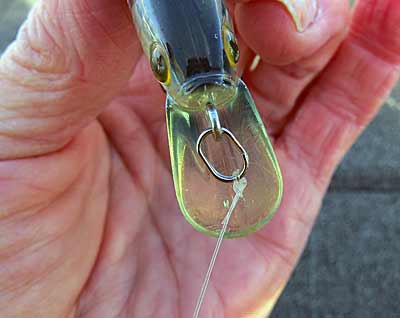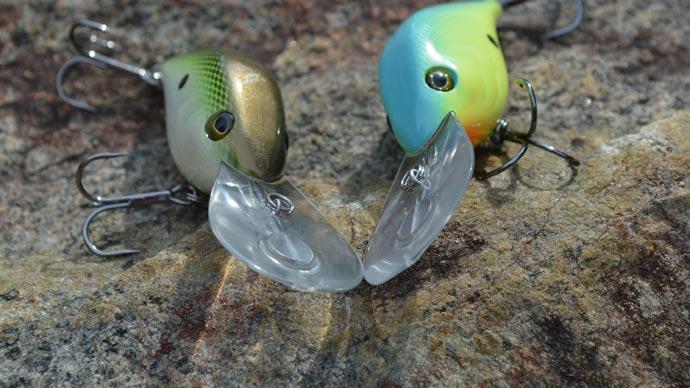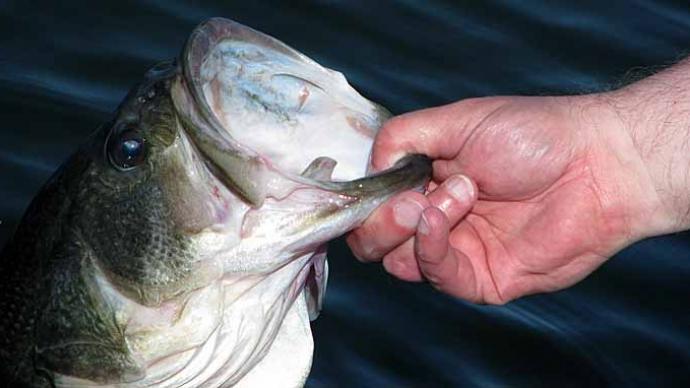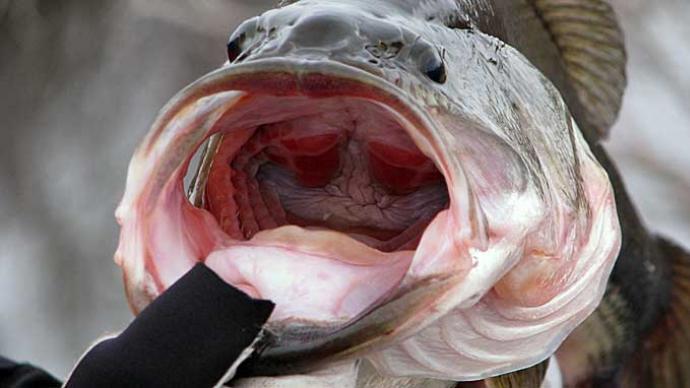
Clifford Kinney loves crankbaits. He and his tournament partner are known by the nickname “Team Plug” because they have won so much money on crankbaits. A lot of guys only think of fishing cranks in spring and fall, but Kinney fishes them all year long, and in fact, he thinks summer is prime time for cranking, even in the deep Arizona reservoirs. “Fish don’t stay deep all the time,” he says, “even in the summer. Some fish are always up shallow, and those fish usually look for a quick meal.”
Where To Fish Cranks In Summer
Kinney likes to target areas with close access to deeper water in summer, so points, banks along river channels, and even ledges along canyon walls are all targets. He also cranks boulders and grass, ripping the plug through grass and crashing it into the boulders. “I once found a spot that was maybe three by eight feet,” he says, “behind a boulder that was pretty close to shore. I’d cast as close to the shore as I could, then smack my bait into that boulder, and every time I’d get hit by a big bass.” The exact spot was consistent for him cast after cast, but as the days went by, it became less and less productive. That taught him to fish a great-looking spot more than once, so if he catches a fish, he throws it again to the same spot.
Typically, Clifford runs the bank, casting a crankbait at a 45-degree angle to the bank, looking for active fish. When he gets to a point, he stops and throws several times in one direction, then turns the boat around and fishes it again in the opposite direction. Once he’s done that, he’ll back off and fish the point lengthwise, fan casting to cover the entire point. When he finds a deeper boulder or any submerged structure, he fishes every side of it, bumping the structure and moving the bait quickly to make the fish react. He says the Strike King Pro 10XD will reach about twenty-five feet on a long cast for deeper boulders and structure. Just cast it as far as you can and drag it down.
Kinney fished the Urban Lakes in Arizona for years and participated in the Arizona Urban Tournament Group derbies. He recommends square bills for those shallow urban lakes, specifically the Strike King square bills designed to go 1.5 to 2.5 feet deep. These baits, he says, can be used not just to catch fish on the urban lakes but also to explore the lake bottom. You can tell where the deeper holes are and find any structure in the lake by running these shallow plugs around. Just walk the bank and keep on casting.
Baits And Gear

For Kinney, just two baits are all he uses 90% of the time. One is a Strike King Pro 5XD in Natural Bream, and the other is the 10XD. He says the Natural Bream 5XD works everywhere, in any season. However, if he is fishing the deeper-running 10XD at night, his philosophy is based on the moon. During the day, he fishes the 10XD in the Natural Bream, but at night, if there is no moon, he favors the 10XD in the Delta Red because it profiles against the sky better. If there’s a moon at night, he uses the 10XD in the Barfish color – he likes the detail on that pattern.
Since he fishes his crankbaits relatively fast, Clifford likes a faster reel. He uses an Abu Garcia Revo SX 6.4:1 on a Lew’s Super Duty Custom Plus Speed Stick, a 7-foot, 11-inch model in medium-heavy with a moderate-fast tip. He uses 10-pound-test Sunline Sniper because the fluorocarbon line sinks and helps him get the bait down further. Because he usually catches big fish on the 10XD, he fishes it with a Bass Pro Shops Pro Qualifier 2 with a 7.5:1 gear ratio and 17-pound-test Sunline Sniper. He uses the same Lew’s Super Duty Custom Plus Speed Stick but in heavy instead of medium-heavy.
Technique
Kinney especially tries to bump things with his plugs because the erratic action when it bounces off things tends to trigger bites. Speed and crashing are the keys, he says, because he wants to make the bait look different and force the bass to decide right now to grab it or let it go. Once he bumps something, he pauses for just a couple of seconds. If a fish is chasing it, he says, it will either bump into the bait and grab it at this point or veer off. He feels for a kick, especially if he’s been running it long enough to think he’s got some interested fish going. If dragging it up and over things doesn’t work, that’s when he’ll do a little stop and count to three, then start reeling again.
Although cranking is what he excels at and does most of the time, he says you also have to pay attention to the barometer. If the barometer rises, especially in summer, you may be better off with a drop shot in the middle of the day. But if it’s windy, the barometer is falling, or it’s nighttime, then you can bet Kinney will be flinging plugs and catching bass.
More Cranking Tips (from various pros)
- Concentrate on how the bait feels when you retrieve it until you know the feel of the lure. Then when it feels different, you’ll know you have a fish on.
- Use your electronics to find prime areas where deeper fish aren’t accustomed to crankbaits: creek channels, long points, underwater islands, and submerged structures.
- If you want to fish a wall, tune the bait, so it runs to the right or the left, and it will bounce off the cliff as it goes.
- Add weight to make a lure go deeper or suspend when it stops. Add weight toward the front, so it runs bill down. Drill a hole, insert a split shot, then fill and paint.
- If you don’t want to drill holes in a bait, you can wrap the lead wire around the hook shaft.
- Add flash to the front treble – adding to the back treble might make the lure roll.
- Use a crankbait that runs deeper than the water you’re fishing. Use a floating bait, and let it float up when it crashes to the bottom.
- If your bait runs crooked, hold it up facing you. If it’s running to the left, bend the eye slightly to the right, and vice versa.
- Putting a slip sinker on the line will not only help your lure get down further, but it will also help keep it down. It also makes it easier to cast small plugs.
- Fish pick up the vibration of a crankbait first, then they are drawn in by flash and color.
- If you are using mono, line smaller than 10-pound-test will stretch and make you lose depth.
- Heavy line has more drag, making you lose depth. The heavy line can also dampen the vibration of a lure. Kinney uses fluorocarbon to avoid this.
- Longer casts equal more depth, especially with lighter or thinner line.
- An untuned bait loses depth by going sideways.
- If you use braid, you have to compensate for no stretch by using a soft rod. If you don’t, the tension can slingshot the lure right out of the fish’s mouth.
- Large schools of bass at over twenty feet in summer can be reached if you use a long rod on the soft side and light line. It’s physically demanding but worthwhile.
- Your crankbait will be at its deepest when it is about 2/3 of the way back to the boat.
- In general, wood lures have a wider wobble, and plastic ones have a tighter wobble.
- Countdown lures cast easily and usually have a tighter wobble. They sink about six to twelve feet per second and tend to stay around that depth during a steady retrieve.
- Burning a countdown bait often works on spooky bass like on pressured lakes, etc. They don’t have time to make up their mind, and they will slam it. Use shad patterns and crank just as fast as you can without turning them over. This applies to lures such as countdown Rapalas, Rat-L-Traps, etc.
- When retrieving, hold the rod tip down, but don’t point it at the lure. When you feel the fish, keep reeling – don’t horse it or give a big hookset.
- If you can see fish on the graph, change your retrieve until you discover what makes them bite. Sometimes you may need to slow down, speed up, bump something, etc.
- A slow retrieve will first get the crankbait down to its deepest.
- When you feel a fish, give him time to get the bait in his mouth. Being too quick on the draw might pull the lure away from him.
- Huge fish can tear loose because some hooks don’t just poke; they cut. Loosen your drag if you need to, and let the fish wear himself out. In heavy cover, about all you can do is keep the rod down and try not to let them jump.
- Always stop the crankbait by the boat, then give it a couple more cranks. Smallmouth will hit it right next to the boat a lot of times.
- Pay attention to how they eat the bait. If they get the back hook, either slow down or change colors.
- On points and humps, try sitting on the high spot and dragging the bait uphill.
- For fishing through the brush, a crankbait with a broader bill will get through more efficiently.
- If you want to keep a big lure running shallow, use thicker line.
- Keep your finger under the line just before the reel and watch your line. The rod tip shakes as the lure goes through the water. If it stops shaking, set the hook by reeling fast.
- You probably miss a lot of fish on crankbaits and never know it. You’ve got to learn to feel the bait as you retrieve.
- When the water level is dropping, the fish will move off and suspend. They will be at the same depth but out. When the water starts rising again, they’ll move right back up.
- If the herons are wading, you can fish fast. If they are sitting on hills, go slow.
- Fish like to face up-current. Go with the flow.
- Using oval split rings will help your crankbait fishing because the line won’t get caught on the oval ones as on round ones. Switching out all your split rings is time well spent.
- Pay attention to places where the bank changes, like rock to sand. Bass-like edges.
Crankbaits are great search baits but don’t make the mistake of using them to find active fish. “Team Plug” proves that an excellent crankbait fisherman can catch quality bass regularly.
BassResource may receive a portion of revenues if you make a purchase using a link above.




